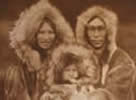Edward S. Curtis is one of the most prominent and recognized photographers of the 20th century; best known for his colossal photography collection “The North American Indian,” nine of which are displayed in this exhibition. He was born in 1868 near Whitewater, Wisconsin, only 130 miles from Dubuque. His adolescence coincided with the emergence of photography as an artistic medium. Photography captivated him from an early age and he would dedicate his life to the medium.
His family moved to Seattle, Washington in 1887 where Curtis became a professional photographer. Curtis honed his artistic skills photographing the residents in the Seattle area. But it was through the opportunities to work as a photographer on expeditions to the north, documenting the geography and indigenous people, that Curtis gained the skills and the desire to travel the country capturing images of North American Indian cultures.
For Curtis, “The North American Indian” project was a race against time. Their culture was rapidly changing and their traditions were disappearing. He received encouragement and financial assistance from President Teddy Roosevelt and J.P. Morgan but the grueling work required all of his energy and more resources than he could raise, subsequently he incurred large personal debt. He spent thirty years creating “The North American Indian” which consisted of 20 illustrated volumes of ethnographic text and over 720 large-format photogravures. He took more than 40,000 photographs; made over 10,000 recordings of Native speech and music; and produced lectures, slide shows, an opera and a documentary film all based on his this work.
